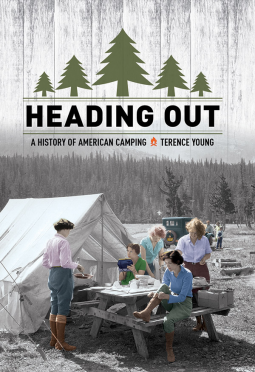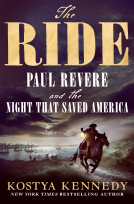
Heading Out
A History of American Camping
by Terence Young
This title was previously available on NetGalley and is now archived.
Send NetGalley books directly to your Kindle or Kindle app
1
To read on a Kindle or Kindle app, please add kindle@netgalley.com as an approved email address to receive files in your Amazon account. Click here for step-by-step instructions.
2
Also find your Kindle email address within your Amazon account, and enter it here.
Pub Date Jun 06 2017 | Archive Date Jun 06 2017
Description
Who are the real campers? Through-hiking backpackers traversing the Appalachian Trail? The family in an SUV making a tour of national parks and sleeping in tents at campgrounds? People committed to the RV lifestyle who move their homes from state to state as season and whim dictate? Terence Young would say: all of the above. Camping is one of the country's most popular pastimes—tens of millions of Americans go camping every year. Whether on foot, on horseback, or in RVs, campers have been enjoying themselves for well more than a century, during which time camping’s appeal has shifted and evolved. In Heading Out, Young takes readers into nature and explores with them the history of camping in the United States.Young shows how camping progressed from an impulse among city-dwellers to seek temporary retreat from their exhausting everyday surroundings to a form of recreation so popular that an industry grew up around it to provide an endless supply of ever-lighter and more convenient gear. Young humanizes camping’s history by spotlighting key figures in its development and a sampling of the campers and the variety of their excursions. Readers will meet William H. H. Murray, who launched a craze for camping in 1869; Mary Bedell, who car camped around America for 12,000 miles in 1922; William Trent Jr., who struggled to end racial segregation in national park campgrounds before World War II; and Carolyn Patterson, who worked with the U.S. Department of State in the 1960s and 1970s to introduce foreign service personnel to the "real" America through trailer camping. These and many additional characters give readers a reason to don a headlamp, pull up a chair beside the campfire, and discover the invigorating and refreshing history of sleeping under the stars.
Advance Praise
“Heading Out is full of original research and insight about the history of camping in the United States. Backpackers, campers, RV enthusiasts, and others with an interest in the history of their pastimes will find this book fascinating."— Philip Terrie, Bowling Green State University, author of Contested Terrain: A New History of Nature and People in the Adirondacks
"From William 'Adirondack' Murray to automobile camping to national parks to RVs, Heading Out provides an engaging overview of the American infatuation with camping. Anyone who has ever pitched a tent or hooked up the family Winnebago will enjoy Terence Young's book."—Thomas A. Chambers, Niagara University, author of Memories of War: Visiting Battlegrounds and Bonefields in the Early American Republic
Available Editions
| EDITION | Other Format |
| ISBN | 9780801454028 |
| PRICE | $35.00 (USD) |
Links
Featured Reviews
In today's modern world, it's easy to understand why someone would leave the hustle of daily living and escape into nature for a little reprieve. As an avid camper, I jumped at the chance to delve deeper into the history of an activity cherished by so many people. I've always wondered where the notion to pack up one's things, leave the comfort of home and rough it for any period of time originated, because it seems to go against humanity's basic tribal instincts. Terence Young does an expert job of revealing and explaining the dichotomies that camping sets up such urban vs rural, socialization vs isolation, and inconvenience vs comfort.
Heading Out: A History of American Camping takes an academic look at how the three major trends of modernization, pilgrimage and changing technology quietly shaped campers' beliefs and attitudes since it's inception. I enjoyed Young's use of biographical stories to help illustrate the different camping methods throughout the years. The use of storytelling pays a bit of an homage to campers huddled around the fire swapping tales, which I found well integrated and made the information more comprehensible. It's apparent that Young is really passionate about the subject, I would definitely recommend this book to my fellow campers with the yearning to learn more about the rise and decline of such a beloved pastime.
 Librarian 395434
Librarian 395434
Heading Out is a thorough history of camping in the U. S. . Lots of detailed references and descriptions. The author received a one year fellowship from the Smithsonian Institute's National Museum of American History along with several important grants in order to help write this book. The author describes the evolution of camping through three trends, modernization, pilgrimage and technological advances. The book contains many vintage pictures of early camping pioneers along with historical details and personal stories of these important figures. The author also discusses the thinking behind the camper who wants to get away from their urban everyday lives. The camper who wants to rough it, yet has many modern conveniences to consider. The book also supposes that the decrease in campers may be caused by an improvement in the nature of American cities.
 Librarian 391714
Librarian 391714
In “Heading out” Young explores the history and attitudes toward camping from the mid-1800’s until present day. While he admits it is not a complete history, it is very comprehensive, featuring many historical details for a reader to grasp a full picture.
Young begins by explaining that camping originated during a time of great modernization when people began yearning for a sense of belonging and connection to nature, an escape from modern life. He recounts several older texts that described camping in the 1800’s and goes on to show how McDonalization changed antimodern camping by easing the challenges primitive camping faced by introducing products like recreational vehicles and easy-to-set-up tents.
"McDonalization transformed camping for the same reason it transformed many other aspects of modern life-it offered greater efficiency, calculability, predictability, and control."
The areas covered in Heading Out include the history of motorized camping, backpacking and policies. I found the information on campground policies quite fascinating. The regulations for these policies are still in use in many areas today which explains the reason for popular one-way roads, and trail set-ups that are so commonly featured in the bigger parks.
 Lori T, Librarian
Lori T, Librarian
Terence Young looks at the phenomenon of camping in America, tracing its evolution over the years. He discusses problems the national parks had with campers and how that led to individual campsites. He also discusses how camping evolved from fairly primitve conditions to RVs. Young's work focuses mainly on camping within the national park and forest systems. The book needed to spend time discussing privately-owned campgrounds, including those with memberships, and chains, such as KOA, or affiliation of privately owned campgrounds with networks such as Good Sam. In spite of this one weakness, it was a very interesting and informative read. I've been reading quite a bit about the formation of Great Smoky Mountain National Park in preparation for an upcoming lecture I'm giving. I was delighted to see the author included some information regarding the way land was acquired for it and Shenanadoah National Park to give the system an Eastern United States presence, although it wasn't new information for me. This review is based on an advance reader's e-galley provided by the publisher through NetGalley in exchange for an honest review.
 Kim C, Educator
Kim C, Educator
This is a non-fiction book that documents the history of camping. Campers and outdoor recreationalists might find this history interesting. How and when did camping become so popular? What led people to leave their homes, go out into nature, and sleep in a tent?
Nowadays, we have all kinds of gear available, and plenty of developed campgrounds to go stay in. But, where did all this begin? When did it become a leisure activity rather than a necessity? The author begins by taking us back to the 1840’s and showing how some early books that described the authors’ camping trips ignited public interest and led to increased visitation to places like the Adirondacks. From there, camping took off.
The book describes not only camping, but how campgrounds and equipment evolved and changed over the years. The earliest campers had few choices for equipment, and much of it was heavy and you needed an automobile to transport it. As time went on, various manufacturers invented lighter and more portable equipment. This history of this makes for pretty fascinating reading. We also learn about the earliest campground designs and how these evolved as travelers’ needs changed. One way loops and designated camping areas all developed as time went on.
Finally, backpacking became more popular. Then, the need was seen to develop some long-distance trails. Thus were born the Pacific Crest Trail and the Appalachian Trail.
I had no idea that all these events had happened. I supposed, like everyone else, I just assumed camping was always and activity and that campgrounds were just built as needed. The story was way more complex and interesting than that though. I really enjoyed reading this history of camping. As a former park employee, it certainly gives me some more background on the system we used in our campgrounds and how it originally developed.
I recommend this book to any park manager, park employees in general, and anyone who loves camping or backpacking. It was an enlightening and thoroughly entertaining look at the activity that we all love.
I’d like to thank NetGalley and the author and publisher for giving me the opportunity to read this novel in exchange for my honest review.
Readers who liked this book also liked:
Jodi Picoult; Jennifer Finney Boylan
General Fiction (Adult), Literary Fiction, Women's Fiction


















